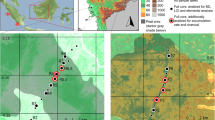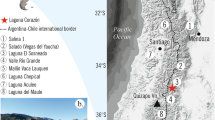Abstract
The Tibetan Plateau is a vast, elevated plateau in Central Asia with an average elevation of over 4,500 m and contains the world’s third largest store of ice. It occupies a climatic transition zone between the Asian monsoons and westerly airflow. As a result of this location, the region is sensitive to changes in climate on timescales of decades to millennia and longer. Long-term data are needed to evaluate climatic changes and their impact on ecosystems, but in areas as remote as the Tibetan Plateau, long-term instrumental records of environmental change are geographically sparse and monitoring has only been undertaken in recent times. Paleolimnological approach might be then one of the few means by which environmental variability can be ascertained at scales that allow comparison with contemporary monitoring data and future model projections. Therefore, a paleolimnological study was undertaken in eight different lakes sampled along a North–South transect across the Tibetan Plateau analysing geochemistry and algal pigment in order to assess longer term variability in the trophic condition of these systems and their potential to reconstruct changes in relation to recent climate evolution and possible human impacts. Chronologies for the last century were based on radiometric techniques (210Pb, 241Am and 137Cs). Results show that inorganic sediment dominates the composition of the cores used in this study. Organic carbon constitutes less than 5% d.w. in all the lake cores, except for Kemen Co core where concentrations up to 14% d.w., are observed. Corg:N ratios are generally in the order of 5–10, indicating that autochthonous algal production is the principal biological source of organic matter. Pigment preservation is generally good throughout the cores from all lakes as shown by the 430:410 nm ratio that is generally around 1.0 or higher. Six out of eight lakes show an increase in primary production in recent times. High pre-1800 AD pigment concentrations were detected only in Qinghai Lake. Since most of the lakes show a similar behaviour in the most recent section of the core, we interpret this as a response to climate and land-use changes that have increased autochthonous production throughout the Tibetan Plateau.




Similar content being viewed by others
References
Appleby, P. G. & F. Oldfield, 1978. The calculation of 210Pb dates assuming a constant rate of supply of unsupported 210Pb to the sediment. Catena 5: 1–8.
Benxing, Z. & N. Rutter, 1998. On the problem of Quaternary glaciations and the extent and patterns of Pleistocene ice cover in the Qinghai-Xizang (Tibet) Plateau Quaternary International: 109–122.
Cruz, R. V., H. Harasawa, M. Lal, S. Wu, Y. Anokhin, B. Punsalmaa, Y. Honda, M. Jafari, C. Li & N. Huu Ninh, 2007. Asia. Climate change 2007: impacts, adaptation and vulnerability. Contribution of working group II. In Parry, M. L., O. F. Canziani, J. P. Palutikof, P. J. van der Linden & C. E. Hanson (eds), Fourth Assessment Report of the Intergovernmental Panel on Climate. Cambridge University Press, Cambridge, UK: 469–506.
Cui, X. & H. F. Graf, 2009. Recent land cover changes on the Tibetan Plateau: a review. Climatic Change 94: 47–61.
Dean, W. E., 1974. Determination of carbonate and organic matter in calcareous sediments and sedimentary rocks by loss on ignition: comparison with other methods. Journal of Sedimentary Petrology 44: 242–248.
Du, M., S. Kawashima, S. Yonemura, X. Zhang & S. Chen, 2004. Mutual influence between human activities and climate change in the Tibetan Plateau during recent years. Global and Planetary Change 41: 241–249.
Gorham, E. J., W. G. Lund, J. E. Sanger & W. E. Dean Jr., 1974. Some relationships between algal standing crop, water chemistry and sediment chemistry in the English lakes. Limnology and Oceanography 23: 777–784.
Gou, X., F. Chen, G. Jacoby, E. Cook, M. Yang, J. Peng & Y. Zhang, 2007. Rapid tree growth with respect to the last 400 years in response to climate warming, northeastern Tibetan Plateau. International Journal of Climatology 27: 1497–1503.
Guilizzoni, P. & A. Lami, 1992. Historical records of changes in the chemistry and biology of Italian lakes. Memorie dell’Istituto Italiano di Idrobiologia 50: 61–77.
Guilizzoni, P. & A. Lami, 2001. Paleolimnology: use of algal pigments as indicators. In Bitton, G. (ed.), Encyclopedia of Environmental Microbiology. John Wiley & Sons, Chichester, UK: 2306–2317.
Guilizzoni, P., G. Bonomi, G. Galanti & D. Ruggiu, 1983. Relationship between sedimentary pigments and primary production: evidence from core analyses of twelve Italian lakes. Hydrobiologia 103: 103–106.
Guilizzoni, P., A. Lami & A. Marchetto, 1992. Plant pigment ratios from lake sediments as indicators of recent acidification in alpine lakes. Limnology and Oceanography 37: 1565–1569.
Guilizzoni, P., A. Lami, M. Manca, S. Musazzi & A. Marchetto, 2006. Palaeoenvironmental changes inferred from biological remains in short lake sediment cores from the Central Alps and dolomites. Hydrobiologia 562: 167–191.
Heiri, O., A. F. Lotter & G. Lemcke, 2001. Loss on ignition as a method for estimating organic and carbonate content in sediments: reproducibility and comparability of results. Journal of Paleolimnology 25: 101–110.
Henderson, A. C. G. & J. A. Holmes, 2009. Palaeolimnological evidence for environmental change over the past millennium from Lake Qinghai sediments: a review and future research prospective. Quaternary International 194: 134–147.
Hodgson, D. A., W. Vyverman, E. Verleyen, K. Sabbe, P. R. Leavitt, A. Taton, A. H. Squier & B. J. Keely, 2004. Environmental factors influencing the pigment composition of in situ benthic microbial communities in east Antarctic lakes. Aquatic Microbial Ecology 37: 247–263.
Holmes, J. A., E. R. Cook & B. Yang, 2009. Climate change over the past 2000 years in Western China. Quaternary International 194: 91–107.
Jiawu, Z., J. Ming, F. Chen, R. W. Battarbee & A. C. G. Henderson, 2003. High-resolution precipitation variations in the Northeast Tibetan Plateau over the last 800 years documented by sediment cores of Qinghai Lake. Chinese Science Bulletin 48: 1451–1456.
Kapp, J. L. D. A., T. M. Harrison, P. Kapp, M. Grove, O. M. Lovera & D. Lin, 2005. Nyainqentanglha Shan: a window into the tectonic, thermal, and geochemical evolution of the Lhasa block, southern Tibet. Journal of Geophysical Research 110: B08413.
Kehrwald, N. M., L. G. Thompson, T. Yao, E. Mosley-Thompson, U. Schotterer, V. Alfimov, J. Beer, J. Eikenberg & M. E. Davis, 2008. Mass loss on Himalayan glacier endangers water resources. Geophysical Research Letters 35: L22503.
Lami, A., F. Niessen, P. Guilizzoni, J. Masaferro & C. A. Belis, 1994. Palaeolimnological studies of the eutrophication of volcanic Lake Albano (central Italy). Journal of Paleolimnology 10: 181–197.
Lami, A., N. Cameron & A. Korhola, 2000a. Paleolimnology and ecosystem dynamics at remote European Alpine lakes (Mountain Lakes Research programme, MOLAR). Journal of Limnology 59 (Suppl.): 119.
Lami, A., P. Guilizzoni & A. Marchetto, 2000b. High resolution analysis of fossil pigments, carbon, nitrogen and sulphur in the sediments of eight European Alpine lakes: the MOLAR project. Journal of Limnology 59 (Suppl.): 15–28.
Leavitt, P. R., 1993. A review of factors that regulate carotenoid and chlorophyll deposition and fossil pigment abundance. Journal of Paleolimnology 9: 109–127.
Leavitt, P. R., M. Reasoner, R. Pienitz, D. A. Hodgson, B. F. Cumming & J. Smol, 2003. Climatic control of ultraviolet radiation effects on lakes. Limnology and Oceanography 48: 2062–2069.
Liu, X. & B. Chen, 2000. Climatic warming in the Tibetan Plateau during recent decades. International Journal of Climatology 20: 1729–1742.
Meyers, P. A. & E. Lallier-Vergès, 1999. Lacustrine sedimentary organic records of late Quaternary. Journal of Paleolimnology 21: 345–372.
Michelutti, N., A. P. Wolfe, R. D. Vinebrooke, B. Rivard & J. P. Briner, 2005. Recent primary production increases in arctic lakes. Geophysical Research Letters 32: L19715. doi:19710.11029/12005GL023693.
Mitchell, M. J., J. S. Owen & S. C. Schindler, 1990. Factors affecting sulfur incorporation into lake sediments: paleoecological implications. Journal of Paleolimnology 4: 1–22.
Moss, B., 1968. Studies on the degradation of chlorophyll a and carotenoids in freshwaters. New Phytologist 67: 49–59.
Plater, A. J., J. F. Boyle, C. Mayers, S. D. Turner & R. W. Stroud, 2006. Climate and human impact on lowland lake sedimentation in Central Coastal California: the record from c. 650 AD to the present. Regional Environmental Change 6: 71–85.
Qiu, J., 2008. The third pole. Nature and Science 454: 393–396.
Renberg, I. & H. Hansson, 2008. The HTH sediment corer. Journal of Paleolimnology 40: 655–659.
Sanger, J. E., 1988. Fossil pigments in paleoecology and paleolimnology. Palaeogeography, Palaeoclimatology, Palaeoecology 62: 342–359.
Shuman, B., 2003. Controls on loss-on-ignition variation in cores from two shallow lakes in the northeastern United States. Journal of Palaeolimnology 30: 371–385.
Smol, J. P. & M. S. Douglas, 2007. From controversy to consensus: making the case for recent climate change in the Arctic using lake sediments. Frontiers in Ecology and in the Environment 5: 466–474.
Smol, J. P., I. R. Walker & P. R. Leavitt, 1991. Paleolimnology and hindcasting climatic trends. Internationale Vereinigung für Theoretische und Angewandte Limnologie 24: 1240–1246.
Smol, J. P., A. P. Wolfe, H. J. B. Birks, M. S. V. Douglas, V. J. Jones, A. Korhola, R. Pienitz, K. Ruhland, S. Sorvari, D. Antoniades, S. J. Brooks, M. A. Fallu, M. Hughes, B. E. Keatley, T. E. Laing, N. Michelutti, L. Nazarova, M. Nyman, A. M. Paterson, B. Perren, R. Quinlan, M. Rautio, E. Saulnier-Talbot, S. Siitoneni, N. Solovieva & J. Weckstrom, 2005. Climate-driven regime shifts in the biological communities of arctic lakes. Proceedings of the National Academy of Sciences of the United States of America 102: 4397–4402.
Talbot, M. R., 2001. Nitrogen isotopes in palaeolimnology. In Last, W. M. & J. P. Smol (eds), Tracking Environmental Change using Lake Sediments. Vol. 2. Physical and Geochemical Methods. Kluwer Academic Publishers, Dordrecht, The Netherlands: 401–439.
Xu, Z. X., T. L. Gong & J. Y. Li, 2008. Decadal trend of climate in the Tibetan Plateau—regional temperature and precipitation. Hydrological Processes 22: 3056–3065.
Yao, T., J. Pu, A. Lu, Y. Wang & W. Yu, 2007. Recent glacial retreat and its impact on hydrological processes on the Tibetan Plateau, China and surrounding regions. Arctic, Antarctic and Alpine Research 39: 642–650.
Zhu, L. P., Y. H. Wu, J. B. Wang, X. Lin, J. Ju, M. P. Xie, M. H. Li, R. Mäusbacher, A. Schwalb & G. Daut, 2008. Environmental changes since 8.4 ka reflected in the lacustrine core sediments from Nam Co, central Tibetan Plateau, China. The Holocene 18: 831–839.
Züllig, H., 1985. Pigmente phototropher Bakterien in Seesedimenten und ihre Bedeutung für die seenforshung (mit Ergebnissen aus dem Lago Cadagno, Rotsee und Lobsigensee). Schweizerische Zeitschrift fur Hydrobiologie 47: 87–126.
Acknowledgements
This study is part of the project ‘Lake Sediment Evidence for Long-Range Air Pollution on the Tibetan Plateau’ funded by the Leverhulme Trust (Project F/07 134BF). We would like to thank also the Ev-K2-CNR ‘SHARE’ Project financial support given to the CNR-ISE staff. Fieldwork would have been impossible without the support of the Institute of Tibetan Plateau Research (ITP), Chinese Academy of Sciences, Beijing. The comments of D. Hodgson and an anonymous reviewer greatly improved the manuscript.
Author information
Authors and Affiliations
Corresponding author
Additional information
Guest editors: Hilde Eggermont, Martin Kernan & Koen Martens / Global change impacts on mountain lakes
Rights and permissions
About this article
Cite this article
Lami, A., Turner, S., Musazzi, S. et al. Sedimentary evidence for recent increases in production in Tibetan plateau lakes. Hydrobiologia 648, 175–187 (2010). https://doi.org/10.1007/s10750-010-0263-2
Published:
Issue Date:
DOI: https://doi.org/10.1007/s10750-010-0263-2




